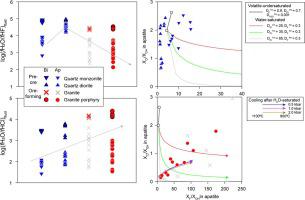当前位置:
X-MOL 学术
›
Ore Geol. Rev.
›
论文详情
Our official English website, www.x-mol.net, welcomes your
feedback! (Note: you will need to create a separate account there.)
Volatile components and magma-metal sources at the Sharang porphyry Mo deposit, Tibet
Ore Geology Reviews ( IF 3.2 ) Pub Date : 2020-11-01 , DOI: 10.1016/j.oregeorev.2020.103779 Junxing Zhao , Kezhang Qin , Noreen J. Evans , Guangming Li , Ruizhe Shi
Ore Geology Reviews ( IF 3.2 ) Pub Date : 2020-11-01 , DOI: 10.1016/j.oregeorev.2020.103779 Junxing Zhao , Kezhang Qin , Noreen J. Evans , Guangming Li , Ruizhe Shi

|
Abstract Volatiles in magmatic‐hydrothermal fluids play an essential role in the formation of porphyry ore deposits. Models of F, Cl and S partitioning between silicate melt, fluid and volatile-bearing minerals (biotite and apatite) in the magmatic system provide an opportunity to estimate halogen fugacity in the fluids and F-Cl-S concentrations in the ore-related magmas. This work integrates mineralogical and isotopic studies of multi-stage intrusions in the Sharang porphyry Mo deposit, with the aim of tracing the evolution of magmatic volatile components in the magmatic-hydrothermal system and elucidating the origin of magma and ores. Sharang apatite compositions in pre-ore and ore-forming intrusions were likely formed at different fractional crystallization stages from volatile-undersaturated to H2O-saturated melts. Magmatic fluids that equilibrated with pre-ore melts were HCl-rich, while the exsolved fluids from the granite porphyry were enriched in HF. Magmatic Cl-F-S contents varied accordingly, and above 700 °C, the felsic causative melts likely had high F (ca. 2700 ppm), low Cl (ca. 130 ppm) and high S contents (ca. 300 ppm). Fluid exsolution was likely the main control over a decrease in magmatic Cl concentrations, while the deep magma source chamber appears to have been recharged by a more mafic S-Cl rich magma at the time of quartz diorite emplacement, elevating the sulfur content of the magma. The magma and sulfides likely originated from subduction-modified mantle and Lhasa terrane basement, which were also responsible for the generation of a high-F, Mo-mineralizing magma.
更新日期:2020-11-01











































 京公网安备 11010802027423号
京公网安备 11010802027423号